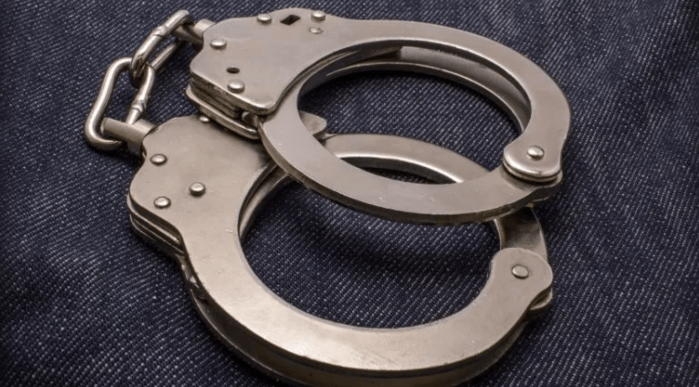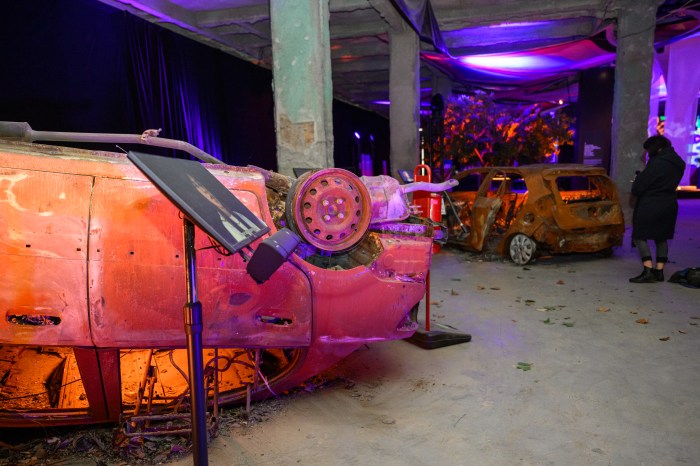Mitchyll Mora (left) was among a group of young people whoturned out at a City Hall rally several years ago opposing theprofiling of LGBTQ New Yorkers. | STREETWISE AND SAFE
BY RYAN HOWE | In 2012, Mitchyll Mora was walking to a poetry reading on the Lower East Side wearing high-heeled boots. Suddenly, three police officers ran toward him yelling at him to “get against the wall.” One of the officers grabbed his butt and called him a “faggot” before letting him continue on his way.
Mora is not alone. In addition to communities of color, homeless, and low-income communities in New York, LGBT youth and adults have complained of experiencing police profiling — in their cases based on gender and sexuality.
“There are so many testimonials of similar instances,” Andrea J. Ritchie, coordinator at Streetwise and Safe, said. “A lot of people feel trapped when they are surrounded by one, two, or even three armed people with badges and don’t know their rights. We are fighting to change that. To help protect not jut people in the LGBT community, but everyone.”
Policy paper offers detailed recommendations for curbing abuses aimed at LGBT, HIV/ AIDS communities
Earlier this month, the Center for Gender & Sexuality Law at Columbia Law School released “A Roadmap for Change: Federal Policy Recommendations for Addressing the Criminalization of LGBT People and People Living with HIV,” which outlined in detail criminal justice issues facing these communities. Prime among them are the profiling and discriminatory policing that Mora and countless others have faced.
But the report goes further than that, offering federal policy recommendations for each issue explored. Specifically, it is intended to “provide analysis that will serve as a resource for policy makers and advocates alike.”
“The report covers a lot of ground with a lot of different agencies,” explained Urvashi Vaid, an attorney affiliated with the Center at Columbia, who is a longtime activist and one of the report’s authors. “So, what we have done is put together this advocacy coalition, and we are going to work together in a coordinated way with the agencies noted in the recommendations.”
Vaid worked closely with fellow advocates from Columbia, Streetwise and Safe, the Center for HIV Law and Policy, and the Center for American Progress in Washington to produce the report. She emphasized the importance of this kind of effort, focusing on issues in the LGBT community other than marriage equality.
Even though the specific fight for marriage equality is picking up momentum, with victory in 19 states and challenges ongoing in every remaining state except for North Dakota, the overall fight for equality is far from over, Vaid said.
“One of the things I appreciate about this report is that we are working in a concerted way toward many hot topic issues,” she said. “For too many gay people, we are narrowing the focus of our issues, and we need to stretch that focus.”
Indeed, the report stretches that focus to six different issues that LGBT people and those living with HIV/ AIDS face —policing and law enforcement, prisons, drivers of incarceration, immigration, criminalization of youth, and criminalization of HIV.
Despite the detailed recommendations discussed, the progress is still at the starting point of the roadmap on many of these issues. But with 16 LGBT organizations, including the National Gay and Lesbian Task Force, Lambda Legal, and the American Civil Liberties Union’s LGBT and HIV/ AIDS unit already involved in the efforts, the coalition can start working on more than one at a time, Vaid explained.
“We don’t have a specific layout of x, y, and z issues that are going to be worked on first,” she said. “Some are going to be harder than others. For example, [the Prison Rape Elimination Act] has taken a great stride in the right direction, but we are far from eliminating rape and how it is operationalized in prison.”
PREA was passed in 2003 with the purpose of eliminating sexual harassment and abuse among incarcerated populations through administrative action and by providing funding for research programs, training, and technical assistance to address the issue. It took nearly a decade, however — until May 2012 — for the draft standards for the elimination of prison rape to be finalized. On May 6 of this year, the Department of Homeland Security put the final standards into effect in immigration detention and other facilities it controls.
According to the Department of Justice’s most recent report on sexual violence in prison, half of gay and bisexual inmates reported sexual victimization while imprisoned. Among women, 20 percent of lesbians and 25 percent of those who identify as bisexual reported such victimization.
Within the criminal justice establishment and among political leaders, there is growing awareness of a crisis of sexual victimization in federal, state, and juvenile detention centers, said Chris Daley, deputy executive director of Just Detention International.
“Now that we know we can actually fix it, we need to start fixing it,” he said.
Even after a decade, PREA is still in the early stages of implementation and impact. For Daley, it needs to be expanded not only into prisons but also into police cars and assisted living centers.
“It is our responsibility to keep an open line of communication about the issue and keep moving forward,” Daley said. “We have to make new changes, and some of those changes are going to take a very long time.”
Working with different advocacy groups could help speed up the process, Vaid said.
Although “Roadmap for Change” includes a testimonial from former National Association for the Advancement of Colored People (NAACP) president Ben Jealous, the coalition has yet to enroll the leading civil rights organizations outside of the LGBT and AIDS communities in the effort the report lays out.
Any groups working toward decriminalization of behaviors stigmatized based on race, ethnicity, orientation, occupation, or health status represent natural allies, its authors emphasize.
“We want to join forces with any broad criminal justice advocacy groups,” Vaid said. “Combining with these groups and working together is what is going to be getting stuff done.”
Vaid and the coalition recognize that these changes aren’t going to happen overnight, or even over the next several years.
Catherine Hanssens, executive director of the Center for HIV Law and Policy, has grown accustomed to the baby steps her group has been taking for years as it continues to work on the decriminalization of HIV and its transmission on both a federal and state level. In the most recent sign of progress, on May 27, Iowa Republican Governor Terry Branstad announced he will sign a decriminalization measure approved overwhelmingly by the Legislature early this month.
The first step for a change in law is educating people on the issue, Hanssens said.
“If the Centers for Disease Control would release a statement about what exactly HIV is, how it is transmitted, how it affects people, and that it isn’t a death sentence, our job would be much easier,” she said. “And even though the steps are small, at least we are moving at some pace. I think that can be said about a lot of these issues.”


































